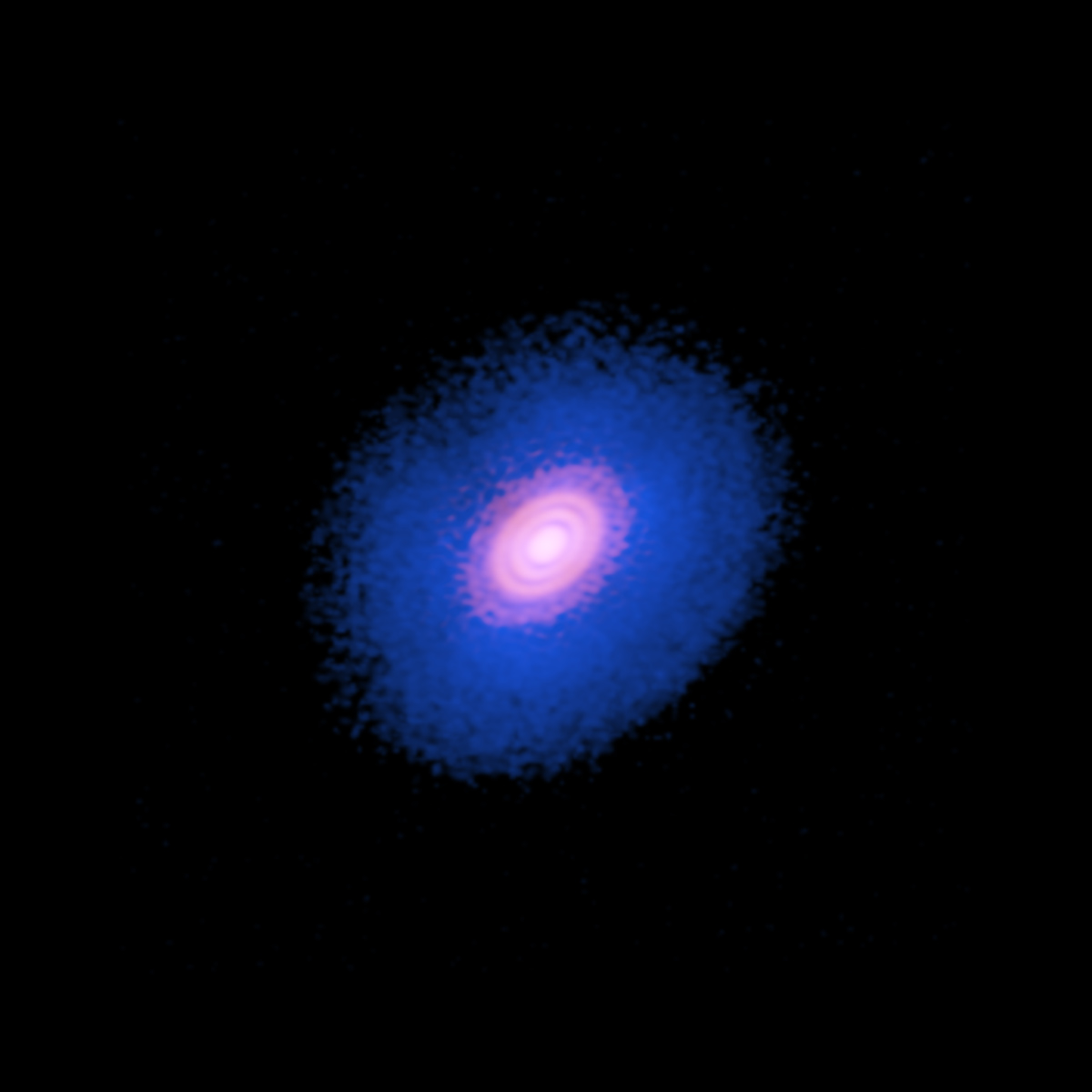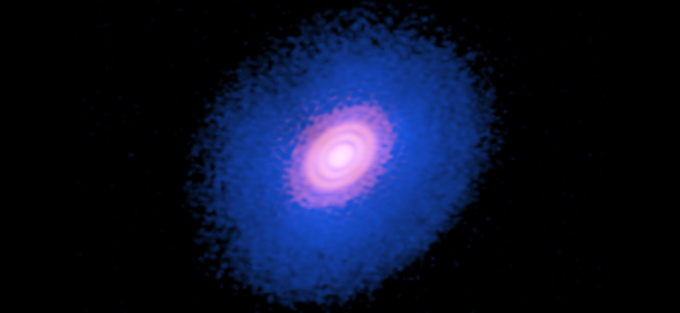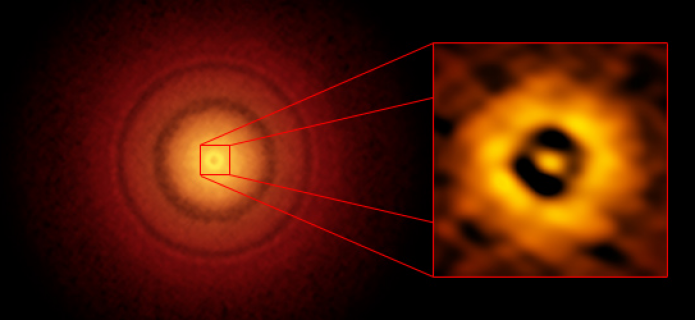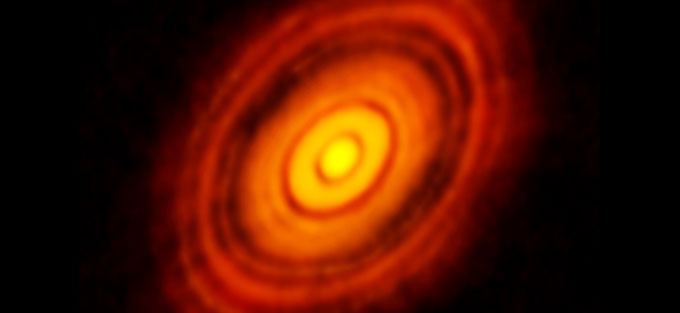ALMA Finds Compelling Evidence for Pair of Infant Planets around Young Star
Astronomers now know that our galaxy is teeming with planets, from rocky worlds roughly the size of Earth to gas giants bigger than Jupiter. Nearly every one of these exoplanets has been discovered in orbit around a mature star with a fully evolved planetary system.
Video of ALMA's recent observations of the young star HD 163296 and how the dust and gas profiles of its protoplanetary disk may herald the presence of two infant planets. Credit: Written and Narrated by C. Blue, NRAO/AUI/NSF; Produced by A. Angelich, NRAO/AUI/NSF Additional Animation and Video from ALMA (ESO/NAOJ/NRAO)/A. Isella, C. Brogan, L. Cieza, M. Kornmesser, B. Saxton (NRAO/AUI/NSF); ESO/L. Calçada, M. Kornmesser, C. Malin (christophmalin.com); NASA/GSFC Conceptual Image Lab; ESA/Hubble/M. Kornmesser, L. L. Christensen; NSF/A. Khan; S. Andrews (Harvard-Smithsonian CfA). Music by Mark Mercury
New observations with the Atacama Large Millimeter/submillimeter Array (ALMA) contain compelling evidence that two newborn planets, each about the size of Saturn, are in orbit around a young star known as HD 163296. These planets, which are not yet fully formed, revealed themselves by the dual imprint they left in both the dust and the gas portions of the star’s protoplanetary disk.

ALMA image of the protoplanetary disk surrounding the young star HD 163296 as seen in dust. New observations suggested that two planets, each about the size of Saturn, are in orbit around the star. These planets, which are not yet fully formed, revealed themselves by the dual imprint they left in both the dust and the gas portions of the star’s protoplanetary disk. Credit: ALMA (ESO/NAOJ/NRAO); A. Isella; B. Saxton (NRAO/AUI/NSF) | Download image
Previous observations of other young star systems have helped to reshape our understanding of planet formation. For example, ALMA’s images of HL Tauri and TW Hydrae revealed striking gaps and prominent ring structures in the stars’ dusty disks. These features may be the tantalizing first signs that planets are being born. Remarkably, these signs appeared around much younger stars than astronomers thought possible, suggesting that planet formation can begin soon after the formation of a protoplanetary disk.
"ALMA has shown us amazing images and never-before-seen views of the rings and gaps around young stars that could be the hallmarks of planet formation. However, since we were only looking at the dust in the disks with sufficient detail, we couldn’t be sure what created these features," said Andrea Isella, an astronomer at Rice University in Houston, Texas, and lead author on a paper published in Physical Review Letters.
In studying HD 163296, the research team used ALMA to trace, for the first time, the distribution of both the dust and the carbon monoxide (CO) gas components of the disk at roughly the same level of detail.

Composite image of the protoplanetary disk surrounding the young star HD 163296. The inner red area shows the dust of the protoplanetary disk. The broader blue disk is the carbon monoxide gas in the system. ALMA observed that in the outer two gaps in the dust, there was a significant dip in the concentration of carbon monoxide, suggesting two planets are forming there. Credit: ALMA (ESO/NAOJ/NRAO); A. Isella; B. Saxton (NRAO/AUI/NSF) | Download image
These observations revealed three distinct gaps in HD 163296’s dust-filled protoplanetary disk. The first gap is located approximately 60 astronomical units from the central star, which is about twice the distance from our Sun to Neptune (An astronomical unit – AU – is the average distance from the Earth to the Sun.). The other two gaps are 100 AU and 160 AU from the central star, well beyond the extent of our solar system’s Kuiper Belt, the region of icy bodies beyond the orbit of Neptune.
Using ALMA’s ability to detect the faint millimeter-wavelength “glow” emitted by gas molecules, Isella and his team discovered that there was also an appreciable dip in the amount of CO in the outer two dust gaps.
By seeing the same features in both the gas and the dust components of the disk, the astronomers believe they have found compelling evidence that there are two planets coalescing remarkably far from the central star. The width and depth of the two CO gaps suggest that each potential planet is roughly the same mass as Saturn, the astronomers said.
In the gap nearest to the star, the team found little to no difference in the concentration of CO gas compared to the surrounding dusty disk. This means that the innermost gap could have been produced by something other than an emerging planet.

Artist impression of the protoplanetary disk surrounding the young star HD 163296. By studying the dust (ruddy brown) and carbon monoxide gas (light blue) profiles of the disk, astronomers discovered tantalizing evidence that two planets are forming in the outer two dust gaps in the disk. Credit: B. Saxton, NRAO/AUI/NSF | Download image
“Dust and gas behave very differently around young stars,” said Isella. “We know, for example, that there are certain chemical and physical process that can produce ringed structures in the dust like the ones we have seen previously. We certainly believe these structures could be the work of a nascent planet plowing through the dust, but we simply can't rule out other possible explanations. Our new observations provide intriguing evidence that planets are indeed forming around this one young star.”
HD 163296 is roughly 5 million years old and about twice the mass of the Sun. It is located approximately 400 light-years from Earth in the direction of the constellation Sagittarius.
Additional information
This research is presented in a paper titled "Ringed structure of the HD 163296 disk revealed by ALMA," by Isella et al., published in Physical Review Letters.
The research team is composed by Andrea Isella[1], Greta Guidi[2], Leonardo Testi[2,3], Shangfei Liu[1,4], Hui Li[4], Shengtai Li[4], Erik Weaver[1], Yann Boehler[1], John M. Carperter[5], Itziar De Gregorio-Monsalvo[5], Carlo F. Manara[6], Antonella Natta[7,2], Laura M. Pérez[8], Luca Ricci[9], Anneila Sargent[10], Marco Tazzari[3], and Neal Turner[11].
- [1] Department of Physics and Astronomy, Rice University, 6100 Main Street, MS-108, Houston, Texas 77005, USA
- [2] INAF/Osservatorio Astrofisico di Arcetri, Largo E. Fermi 5, I-50125 Firenze, Italy
- [3] ESO, Karl Schwarzschild str. 2, 85748 Garching bei Mnchen, Germany
- [4] Theoretical Division, Los Alamos National Laboratory, Los Alamos, New Mexico 87545, USA
- [5] Joint ALMA Observatory (JAO), Alonso de Cordova 3107 Vitacura, Santiago de Chile, Chile
- [6] Scientific Support Office, Directorate of Science, European Space Research and Technology Centre (ESA/ESTEC), Keplerlaan 1, 2201 AZ Noordwijk, Netherlands
- [7] School of Cosmic Physics, Dublin Institute for Advanced Studies, 31 Fitzwilliams Place, 2 Dublin, Ireland
- [8] Max-Planck-Institut fr Radioastronomie Bonn, auf dem Hgel 69, D-53121 Bonn, Germany
- [9] Harvard-Smithsonian Center for Astrophysics, 60 Garden Street, Cambridge, Massachusetts 02138, USA
- [10] Division of Physics, Mathematics and Astronomy, California Institute of Technology, Pasadena, California 91125, USA
- [11] Jet Propulsion Laboratory, California Institute of Technology, Pasadena, California 91109, USA
The Atacama Large Millimeter/submillimeter Array (ALMA), an international astronomy facility, is a partnership of the European Organisation for Astronomical Research in the Southern Hemisphere (ESO), the U.S. National Science Foundation (NSF) and the National Institutes of Natural Sciences (NINS) of Japan in cooperation with the Republic of Chile. ALMA is funded by ESO on behalf of its Member States, by NSF in cooperation with the National Research Council of Canada (NRC) and the Ministry of Science and Technology (MOST) in Taiwan and by NINS in cooperation with the Academia Sinica (AS) in Taiwan and the Korea Astronomy and Space Science Institute (KASI).
ALMA construction and operations are led by ESO on behalf of its Member States; by the National Radio Astronomy Observatory (NRAO), managed by Associated Universities, Inc. (AUI), on behalf of North America; and by the National Astronomical Observatory of Japan (NAOJ) on behalf of East Asia. The Joint ALMA Observatory (JAO) provides the unified leadership and management of the construction, commissioning and operation of ALMA.
Contacts
-
Nicolás Lira
Education and Public Outreach CoordinatorJoint ALMA Observatory, Santiago - ChilePhone: +56 2 2467 6519Cel: +56 9 9445 7726Email: [email protected] -
Laura Pérez
Department of Astronomy, University of Chile -
Charles E. Blue
Public Information OfficerNational Radio Astronomy Observatory Charlottesville, Virginia - USAPhone: +1 434 296 0314Cel: +1 202 236 6324Email: [email protected] -
Masaaki Hiramatsu
Education and Public Outreach Officer, NAOJ Chile -
Richard Hook
Public Information Officer, ESOGarching bei München, GermanyPhone: +49 89 3200 6655Cel: +49 151 1537 3591Email: [email protected]



